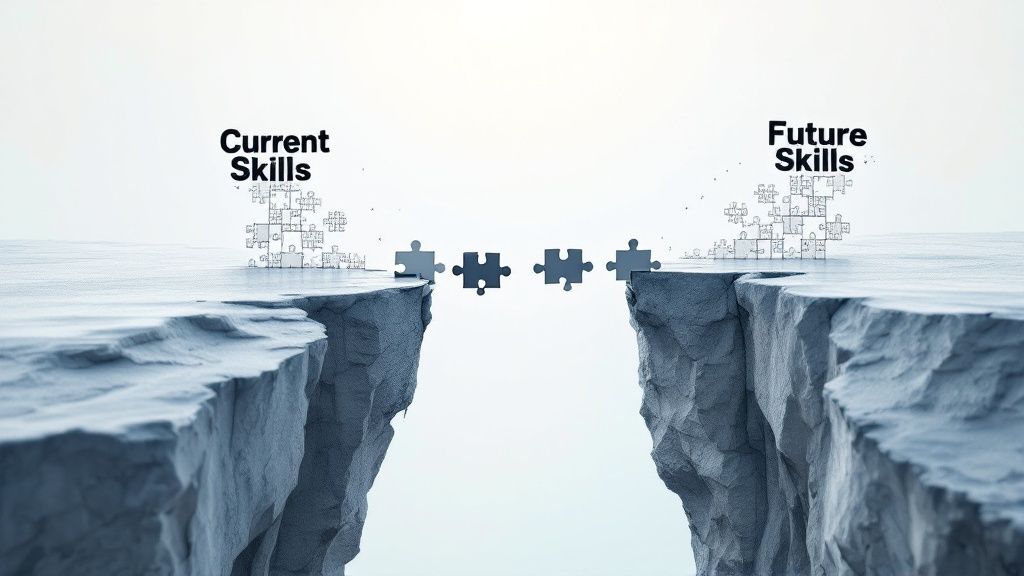In the competitive environment of mid-sized agencies and service teams, having the right people with the right skills at the right time isn't just an advantage—it's the core of your operational success. Too often, organizations fall into a cycle of reactive hiring and gut-feel resource allocation, leading to overworked teams, project delays, and compromised profitability. This is where strategic workforce planning moves beyond a corporate buzzword to become a practical, indispensable tool for sustainable growth. It's the disciplined practice of proactively aligning your talent strategy with your business objectives, ensuring you are always prepared to deliver high-quality work, scale effectively, and outmaneuver the competition.
Effective workforce planning allows you to anticipate future needs, identify critical skill gaps before they become a problem, and optimize your current team’s utilization. By implementing a structured approach, you can ensure every project is staffed for success and every team member is positioned to deliver their best work. Once you've successfully planned for and acquired top talent, the next crucial step is seamless integration. To ensure your newly hired talent integrates smoothly and contributes quickly, consider implementing these 8 onboarding best practices for new hires.
This article breaks down 8 actionable workforce planning best practices into a clear, comprehensive framework. We’ll move beyond theory to provide actionable steps and real-world examples, demonstrating how to build a resilient, high-performing team ready for any challenge. We will also explore how leveraging tools like TimeTackle can automate crucial data collection, providing the deep insights needed to turn these powerful strategies into tangible business results.
1. Strategic Workforce Planning
Strategic Workforce Planning (SWP) is a foundational practice that moves beyond simple headcount forecasting. It's a comprehensive process of analyzing your current workforce and aligning it directly with your long-term business goals. This involves systematically identifying the skills, roles, and number of people your agency will need in the future and then creating a roadmap to bridge the gap between where you are today and where you need to be.
Unlike reactive hiring, which fills immediate vacancies, SWP is proactive. It anticipates future needs driven by market shifts, technological advancements, or new service offerings. For a mid-sized agency, this means looking ahead 1-3 years and asking critical questions: "If we plan to launch a new AI-driven marketing service, what data science and machine learning skills will our team need?" or "As we expand into a new region, what local market expertise is essential for success?"
Why It's a Top Practice
SWP is crucial because it ensures your most valuable asset, your people, are perfectly aligned with your strategic direction. It helps prevent costly skill gaps and talent shortages that can derail growth. For instance, General Electric successfully used SWP to navigate its digital transformation, identifying the need for software engineers and data scientists years in advance and building a talent pipeline to support the shift.
This forward-thinking approach is essential for scaling agencies. By understanding future needs, you can make smarter decisions about hiring, training, and development. It also involves a deep dive into your current team's capabilities, where effective capacity planning strategies become vital for optimizing resource allocation and preventing burnout.
Actionable Implementation Tips
- Start with Strategy: Begin by reviewing your company's strategic plan. Identify the key business objectives for the next 1-3 years and translate them into specific talent requirements.
- Involve Leadership: Ensure senior leaders from all departments (not just HR) are involved from the start. Their insights into future business needs are invaluable for an accurate plan.
- Use Scenario Planning: Don't just plan for one future. Develop best-case, worst-case, and most-likely scenarios to build a flexible and resilient workforce strategy.
- Establish Key Metrics: Track metrics like time-to-fill critical roles, employee turnover rate, and skill gap percentages to measure the effectiveness of your plan. Dive deeper into workforce management with our comprehensive startup guide.
2. Skills Gap Analysis and Future Skills Mapping
A Skills Gap Analysis is a systematic process of identifying the difference between the skills your current workforce possesses and the skills your agency needs to achieve its future strategic goals. It goes beyond a simple inventory, involving a deep analysis of existing competencies, forecasting future skill requirements based on industry trends, and then creating a clear plan to bridge those gaps through targeted training, strategic hiring, or team restructuring.
This practice moves you from reacting to talent needs to proactively building the workforce of tomorrow. For a creative agency, this might mean realizing that while your team is strong in traditional design, you lack expertise in augmented reality (AR) and interactive experience design, which are projected to be major client demands. A skills gap analysis quantifies this need and provides a data-driven case for investment in upskilling or hiring.
Why It's a Top Practice
Conducting a skills gap analysis is one of the most impactful workforce planning best practices because it directly links talent development to business survival and growth. It prevents your agency from becoming obsolete in a rapidly changing market. For example, AT&T famously invested over $1 billion in a massive retraining program to transition its workforce from a legacy telecom to a modern technology company, a move driven entirely by a comprehensive analysis of future skill needs.
This forward-looking approach ensures you are not just filling seats but are building a resilient, adaptable team. By identifying and prioritizing critical skills, you can allocate your training budget more effectively, improve employee retention by offering clear growth paths, and ensure you have the right people on the right projects, maximizing both client satisfaction and profitability.
Actionable Implementation Tips
- Use Multiple Data Sources: Combine employee self-assessments, manager evaluations, project performance data, and client feedback to get a holistic view of current skills. Don't rely on a single source of truth.
- Prioritize Critical Gaps: Not all skill gaps are equal. Focus on the ones that pose the biggest risk to achieving your key business objectives. Ask, "Which missing skill will most hinder our growth in the next 18 months?"
- Create Visual Skills Maps: Use heat maps or dashboards to visually represent the skills landscape across teams or the entire organization. This makes it easier to communicate findings and gain buy-in from stakeholders for your action plan.
- Develop Skills Frameworks: Build a clear framework that defines both the technical (e.g., Python, Figma) and soft skills (e.g., client negotiation, strategic thinking) required for each role. This provides a consistent benchmark for your analysis.
3. Data-Driven Workforce Analytics
Data-Driven Workforce Analytics moves beyond gut feelings and traditional HR metrics. It is the systematic practice of using data analysis tools and techniques to make informed, evidence-based decisions about your people. This involves leveraging business intelligence, HR data, and predictive analytics to understand workforce patterns, anticipate future trends, and optimize your investments in human capital.
Instead of guessing who your top performers are or why a certain department has high turnover, this approach provides concrete answers. For a mid-sized consulting firm, it means analyzing project data to identify which skills lead to the highest client satisfaction or predicting which teams are at risk of burnout based on utilization rates. It transforms HR from an administrative function into a strategic partner that uses data to drive business outcomes.
Why It's a Top Practice
Implementing data-driven workforce analytics is critical because it replaces assumptions with objective insights, leading to more effective and efficient decision-making. It enables you to allocate resources precisely where they will have the most impact. For example, Google's renowned People Analytics team used data to identify the key behaviors of its most effective managers, which then formed the basis of their management training programs, significantly improving team performance and retention across the company.
For growing agencies, this practice is a game-changer. By analyzing data on everything from recruitment to project profitability, you can uncover hidden patterns and opportunities. This analytical approach is fundamental to identifying inefficiencies and is a core component of successful workforce planning best practices. It allows you to address potential problems proactively, such as identifying flight risks among high-performers before they decide to leave.
Actionable Implementation Tips
- Start with Quality Data: Ensure the data you collect (from timesheets, project management tools, HRIS) is clean, accurate, and consistent. Garbage in, garbage out.
- Focus on Business Outcomes: Don't just track metrics for the sake of it. Connect your analytics to key business goals, such as client retention, project margin, or employee productivity.
- Invest in Visualization Tools: Use dashboards and user-friendly tools to present data to non-technical stakeholders. Visual insights are more compelling and easier to understand than raw spreadsheets.
- Establish Data Governance: Create clear policies for data privacy, security, and accuracy to build trust and ensure compliance.
- Build Capabilities Gradually: Start with descriptive analytics (what happened) and diagnostic analytics (why it happened) before moving to more advanced predictive (what will happen) and prescriptive (what should we do) analytics.
4. Scenario Planning and Contingency Workforce Strategies
Scenario planning is a strategic method where you develop multiple plausible future scenarios and create corresponding workforce strategies for each. Instead of betting on a single predicted future, this practice helps your agency prepare for uncertainty by considering various business conditions, market changes, and external factors that could impact your workforce needs. It's about asking "what if" and having a plan ready.
For a mid-sized consulting firm, this might involve creating scenarios for a major economic downturn, the sudden loss of a key client, or a rapid surge in demand for a niche service. For each possibility, you would outline the talent implications: Would you need to upskill existing staff, hire temporary contractors, or reallocate resources from other departments? This proactive approach ensures you can pivot quickly and effectively, rather than reacting in a crisis.
Why It's a Top Practice
In a volatile market, agility is a competitive advantage. Scenario planning builds that agility directly into your workforce strategy, making your organization more resilient. Royal Dutch Shell famously used this technique to anticipate major shifts in the global energy market, allowing them to adapt their workforce and investments far ahead of competitors. It transforms uncertainty from a threat into a strategic opportunity.
This forward-looking exercise is one of the most effective workforce planning best practices for mitigating risk. It forces you to think beyond the immediate future and prepares your leadership team to act decisively when circumstances change. By having contingency plans for talent acquisition, development, and deployment, you can maintain operational stability and protect your business from unforeseen disruptions.
Actionable Implementation Tips
- Involve Diverse Stakeholders: Bring together leaders from finance, operations, sales, and technology to brainstorm potential scenarios. A diverse group will ensure a more comprehensive and realistic range of possibilities.
- Focus on High-Impact Scenarios: Concentrate on developing plans for scenarios that would have the most significant impact on your business, whether positive or negative.
- Establish Clear Triggers: For each scenario, define specific "trigger points" or key indicators that signal it's time to activate your contingency workforce plan. For example, a 20% drop in new client acquisition could trigger a pre-defined cost-saving plan.
- Test Your Plans: Don't let your plans sit on a shelf. Run simulations or tabletop exercises to test your contingency strategies and identify any weaknesses before a real crisis occurs. Regularly review and update scenarios to reflect new market intelligence.
5. Cross-Functional Collaboration in Workforce Planning
Cross-functional collaboration breaks down traditional organizational silos, making workforce planning a shared responsibility rather than an isolated HR function. This approach involves creating a dedicated team with representatives from key departments like HR, finance, operations, and individual business units. Together, they develop a cohesive workforce plan that is deeply integrated with the company's operational realities, financial constraints, and overarching strategic goals.
This collaborative model ensures that workforce decisions are not made in a vacuum. Instead of HR guessing what skills the product team might need, the product lead is at the table providing direct input. Similarly, the finance department can offer immediate feedback on the budgetary impact of hiring plans, ensuring financial feasibility from the outset. This creates a holistic planning process where all perspectives are considered, leading to more robust and realistic outcomes.
Why It's a Top Practice
Collaboration is a top practice because it ensures comprehensive alignment and buy-in across the agency. When different departments contribute to the plan, the final strategy reflects the true needs of the entire organization, not just one part of it. This prevents the common pitfalls of siloed planning, such as hiring for roles that don't align with operational capacity or approving headcount that isn't financially sustainable.
Companies known for operational excellence, like Toyota, use cross-functional teams to align production targets with workforce allocation seamlessly. This integrated approach ensures that they have the right people with the right skills available exactly when and where they are needed. For a mid-sized agency, this means your client services, creative, and project management teams are all in sync, preventing resource conflicts and ensuring that staffing levels can support the sales pipeline.
Actionable Implementation Tips
- Establish Clear Roles: Define who is responsible for what. Create a charter that outlines the roles, responsibilities, and decision-making authority for each member of the cross-functional planning team.
- Create a Communication Rhythm: Schedule regular, structured meetings (e.g., bi-weekly or monthly) to ensure consistent communication and progress. Use a shared agenda and document all key decisions and action items.
- Use Collaborative Platforms: Leverage shared dashboards and planning tools that provide a single source of truth for all departments. This ensures everyone is working with the same data on employee utilization, project timelines, and financial forecasts.
- Align Incentives: Ensure performance metrics for department heads are aligned with the success of the overall workforce plan. This encourages genuine collaboration rather than competition for resources.
6. Flexible and Agile Workforce Models
A flexible and agile workforce model is a strategy that moves beyond the traditional 9-to-5, full-time employee structure. It emphasizes adaptability by building a blended team of full-time employees, specialized contractors, freelancers, and part-time staff. This approach creates a dynamic and scalable workforce that can expand or contract in direct response to project pipelines, market shifts, and fluctuating client demands.
For a mid-sized agency, this means you can quickly onboard a freelance UX designer for a three-month project without the overhead of a full-time hire. Or, you can engage a team of contractors to handle a sudden surge in client work, ensuring you never have to turn down opportunities due to a lack of immediate capacity. This model is about having the right talent, at the right time, for the right duration.
Why It's a Top Practice
Adopting a flexible workforce model is a powerful competitive advantage. It allows agencies to access specialized, high-demand skills on-demand without committing to long-term salary costs, which is crucial for managing operational budgets and profitability. This agility ensures you can pivot quickly, take on diverse projects, and scale your service offerings without the risks associated with rapid, permanent hiring.
Spotify, for example, champions its agile "squad" model, creating small, autonomous teams that can form and disband based on project needs. While they use full-time employees, the principle of flexible, project-based team structures is the same. This approach boosts innovation and efficiency, preventing the organizational rigidity that can stifle growth. For startups and growing agencies, understanding how to manage these dynamic teams is vital; you can explore the fundamentals of workforce management for startups to build a solid foundation.
Actionable Implementation Tips
- Develop Clear Worker Policies: Create distinct guidelines, contracts, and expectations for each worker category (full-time, contractor, freelancer). This prevents legal and compliance issues down the line.
- Invest in a Unified Tech Stack: Use project management and collaboration tools that seamlessly integrate all team members, regardless of their employment status, to ensure smooth communication and workflow.
- Standardize Onboarding for All: Create a streamlined onboarding process for non-permanent staff. This ensures they can integrate quickly with your culture and systems to become productive faster.
- Establish Communication Channels: Define clear channels and protocols for communication. Ensure flexible workers feel included in relevant team meetings and project updates to foster a sense of belonging and alignment.
7. Continuous Monitoring and Performance Measurement
Workforce planning is not a one-time event; it's a continuous cycle that requires constant attention. Continuous Monitoring and Performance Measurement is the practice of systematically tracking the effectiveness of your workforce strategies against established goals. It involves defining key performance indicators (KPIs), implementing systems to track them, and conducting regular reviews to ensure your plan is on track and delivering the desired business outcomes.
This approach transforms your workforce plan from a static document into a dynamic management tool. For a mid-sized agency, this means moving beyond annual headcount reviews and instead asking ongoing questions like: "Is our new training program actually closing the skill gaps we identified?" or "Is our hiring for the new service line keeping pace with our revenue projections?" It’s about creating a feedback loop that allows for real-time adjustments.
Why It's a Top Practice
This practice is essential because it provides the data-driven insights needed to validate your strategy and pivot when necessary. Without measurement, your workforce plan is based on assumptions. By tracking performance, you can prove the ROI of your talent initiatives and make informed decisions. Salesforce, for example, continuously tracks employee engagement metrics as part of its "Ohana" culture, linking employee sentiment directly to business performance and using this data to refine its talent management strategies.
For service-based businesses, this continuous oversight is one of the most critical workforce planning best practices for maintaining agility. It allows you to spot problems early, such as rising turnover in a key department or a decline in team utilization, before they impact client delivery. This proactive management helps optimize resource allocation and ensures your workforce remains aligned with evolving strategic objectives.
Actionable Implementation Tips
- Align Metrics with Business Goals: Don't track vanity metrics. Select KPIs that directly link to your agency's strategic objectives, such as billable utilization rates, time-to-fill for critical roles, and employee productivity.
- Use a Balanced Scorecard: Combine leading indicators (e.g., employee training hours, candidate pipeline health) with lagging indicators (e.g., turnover rate, project profitability) for a holistic view of workforce performance.
- Establish Regular Review Cycles: Schedule monthly or quarterly meetings with leadership to review dashboards, discuss trends, and decide on necessary adjustments to the workforce plan.
- Visualize Your Data: Use tools to create simple, intuitive dashboards that make complex data accessible to all stakeholders. Effective visualization turns raw numbers into actionable stories. For a deeper dive into the foundational data, explore the importance of time tracking for teams.
8. Succession Planning and Leadership Development Integration
Integrating succession planning with leadership development is a forward-thinking practice that prepares your agency for the future. It moves beyond simply identifying a replacement for a key leader and focuses on systematically building a pipeline of internal talent ready to step into critical roles. This approach ensures business continuity, retains top performers, and reinforces a culture of growth from within.
This is not just about the C-suite. For a mid-sized agency, it means identifying crucial roles at all levels, from a senior account director to a lead developer, whose sudden departure would disrupt operations. The goal is to proactively develop the skills and experience of high-potential employees, ensuring a smooth transition and maintaining momentum when vacancies inevitably arise.
Why It's a Top Practice
This practice is essential because it directly mitigates one of the biggest risks to a growing agency: leadership gaps. Losing a key player without a prepared successor can lead to instability, lost client confidence, and a scramble to hire externally, which is often more costly and less reliable. Companies like General Electric and Johnson & Johnson built their enduring success on robust internal leadership development programs that ensured they always had skilled leaders ready.
By creating clear career paths and investing in development, you significantly boost employee engagement and retention. Ambitious team members are more likely to stay when they see a tangible future and growth opportunities within the company. This integration of workforce planning best practices ensures that as your agency scales, your leadership capability scales with it, preventing operational bottlenecks and supporting sustainable growth.
Actionable Implementation Tips
- Identify Critical Roles: Start by identifying positions that are vital to your agency's success and have a high impact on operations or revenue. These are your first priority for succession planning.
- Create Individual Development Plans (IDPs): Work with high-potential employees to build tailored IDPs. These plans should outline specific skills to develop, experiences to gain, and training to complete to prepare them for future leadership.
- Provide Stretch Assignments: Give potential successors opportunities to lead projects, manage small teams, or take on cross-functional responsibilities. These experiences are invaluable for building leadership competencies in a real-world setting.
- Balance Internal and External Talent: While developing internal talent is key, maintain a strategy for external hiring to bring in fresh perspectives and specialized skills that may not exist internally.
Workforce Planning Best Practices Comparison
| Item | Implementation Complexity 🔄 | Resource Requirements ⚡ | Expected Outcomes 📊 | Ideal Use Cases 💡 | Key Advantages ⭐ |
|---|---|---|---|---|---|
| Strategic Workforce Planning | High: complex cross-functional coordination | High: requires data, analytics, leadership buy-in | Significant: long-term alignment with business goals | Organizations seeking long-term workforce alignment | Competitive advantage, cost management, agility |
| Skills Gap Analysis and Future Skills Mapping | Medium-High: extensive data collection and updating | Medium-High: surveys, assessments, forecasting | Moderate-High: improved talent development and agility | Companies facing rapid skill changes, upskilling needs | Proactive development, reduced hiring lag |
| Data-Driven Workforce Analytics | High: requires advanced analytics capability | High: tech investment and skilled analysts | High: accurate forecasting and insight generation | Data-focused orgs aiming for evidence-based decisions | Objective decision making, real-time monitoring |
| Scenario Planning and Contingency Workforce Strategies | High: scenario creation and strategy variation | Medium-High: multiple plans and risk assessments | Moderate-High: enhanced resilience and preparedness | Firms operating in volatile or uncertain markets | Improved risk management, flexibility |
| Cross-Functional Collaboration in Workforce Planning | Medium: ongoing coordination and facilitation | Medium: regular meetings, collaborative tools | Moderate-High: aligned and realistic workforce plans | Organizations needing integrated, cross-departmental planning | Better alignment, faster initiative execution |
| Flexible and Agile Workforce Models | Medium: managing diverse worker types | Medium: technology platforms and management | High: scalable and responsive workforce | Companies with fluctuating demand or project work | Agility, cost optimization, specialized skills |
| Continuous Monitoring and Performance Measurement | Medium-High: KPI frameworks and regular reviews | Medium-High: dashboards, reporting, benchmarking | High: timely identification of issues and ROI | Businesses focused on optimizing workforce effectiveness | Early issue detection, accountability |
| Succession Planning and Leadership Development Integration | Medium-High: identification, development programs | Medium-High: training, mentoring, program management | High: leadership continuity and talent retention | Organizations prioritizing leadership pipeline and growth | Retention, leadership stability, internal growth |
From Planning to Performance: Your Next Steps
Navigating the complexities of the modern service landscape requires more than just reacting to change; it demands a proactive, strategic approach to managing your most critical asset: your people. We've journeyed through eight essential workforce planning best practices, moving from high-level strategic alignment and future skills mapping to the granular, on-the-ground tactics of agile models and continuous performance monitoring. The common thread weaving these practices together is the transition from guesswork to data-driven decision-making, transforming your organization into a resilient, adaptable, and forward-thinking powerhouse.
For mid-sized agencies and service teams, adopting these principles isn't a luxury; it's a strategic imperative for sustainable growth. The days of simply hoping you have the right people with the right skills at the right time are over. Instead, success hinges on your ability to anticipate needs, identify skill gaps before they become critical, and build a talent pipeline that can weather any storm. This comprehensive approach ensures you're not just filling seats but strategically building a team that is a competitive advantage in itself.
Key Takeaways for Immediate Action
The path to mastering workforce planning is a marathon, not a sprint. To avoid feeling overwhelmed, focus on integrating these concepts incrementally. Here are the most critical takeaways to guide your next steps:
- Embrace Data Over Intuition: Your team's calendar data is a goldmine of insights. Stop relying on anecdotal evidence or manual timesheets to understand utilization, project allocation, and operational efficiency. Ground your strategy in hard data to make reliable forecasts and resource allocation decisions.
- Proactive vs. Reactive: Shift your mindset from firefighting to future-proofing. Practices like skills gap analysis, scenario planning, and succession planning are inherently proactive. They empower you to address challenges before they disrupt projects and impact profitability.
- Collaboration is Non-Negotiable: Workforce planning cannot succeed in a silo. True strategic alignment requires active collaboration between HR, finance, operations, and team leadership. Break down departmental barriers to create a unified vision for your talent strategy that supports overarching business goals.
Building Your Implementation Roadmap
The true value of these workforce planning best practices is realized through consistent application. Your journey starts now, with a clear and actionable plan. Begin by assessing your current state. Which of the eight practices addresses your most significant pain point? Are you struggling with poor utilization visibility, or is a looming skills gap a more pressing concern?
Once you've identified your starting point, commit to a small, measurable pilot project. For instance, you could begin by implementing a more data-driven approach to performance measurement for a single department. By using existing calendar data, you can automate the collection of key metrics without introducing the friction of manual timesheets, proving the concept's value quickly.
Your goal is to build momentum. Small, early wins will demonstrate the power of strategic workforce planning and create the buy-in needed to roll out these practices across the entire organization.
Ultimately, mastering these concepts creates a virtuous cycle. Better planning leads to improved employee engagement, as team members see clear paths for growth and development. This, in turn, boosts retention, enhances project outcomes, and drives profitability. You are not just optimizing resources; you are building a more robust, agile, and future-ready organization poised for long-term success.
Ready to replace assumptions with accuracy and automate your data collection? TimeTackle transforms your team's existing calendar data into powerful, actionable insights for utilization tracking, project costing, and strategic workforce planning. See how effortless data-driven decision-making can be by exploring TimeTackle today.







